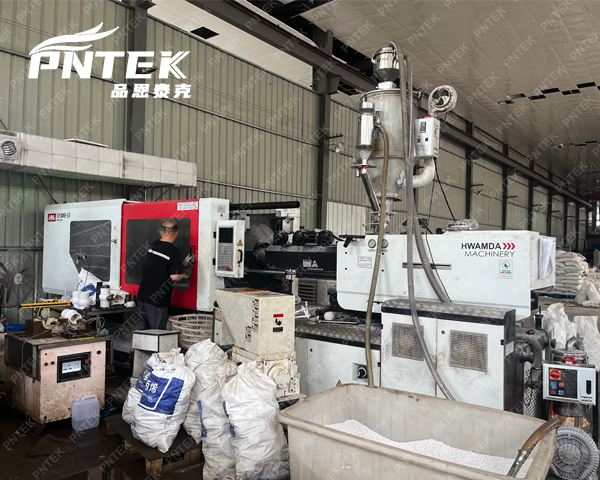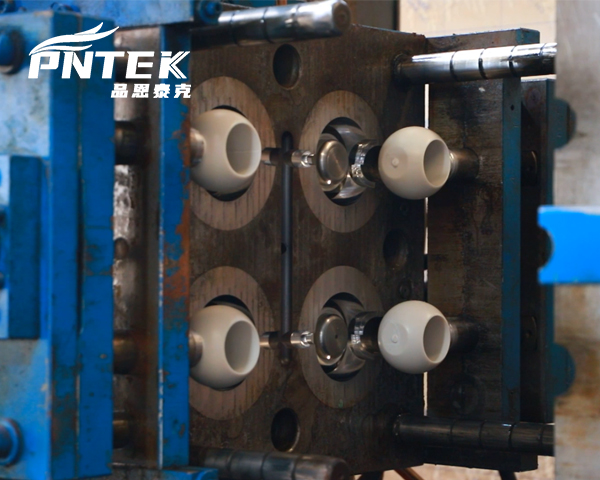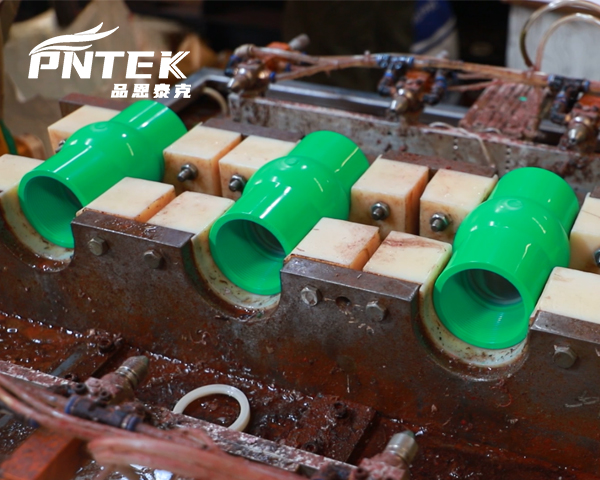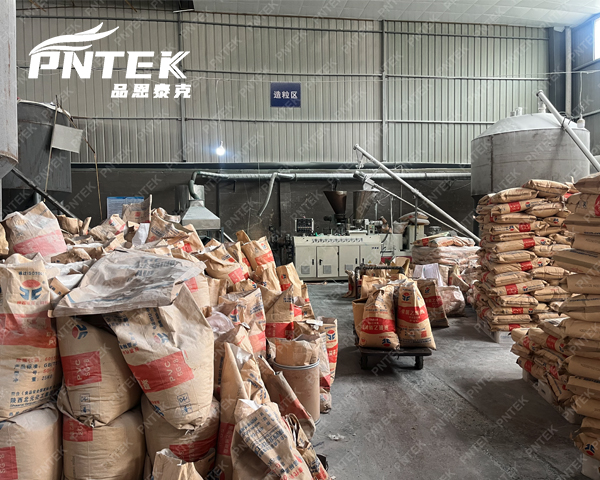You are relying on a simple plastic valve to control water flow, but have you ever wondered how it is made? If a valve fails due to poor manufacturing, it can cause major leaks, property damage, and a loss of trust from your customers.
PVC ball valves are made primarily through injection molding. PVC raw material is melted and injected under high pressure into steel molds to form the body, ball, stem, and handle. These components are then assembled with TPE or EPDM seats and seals.

Whenever Budi visits our factory, I make sure he sees our injection molding workshop first. The sight of dozens of automated machines, the precise hiss of hydraulics, and the fresh PVC parts coming off the conveyor belt tells a powerful story. It is a story about consistency and quality control. Creating a reliable PVC ball valve is not just about having a machine; it is about the quality of the steel molds, the purity of the raw materials, and the precision of the assembly process. Understanding how these parts come together gives our partners confidence that they are not just selling a plastic part, but a piece of engineered reliability.
How are ball valves manufactured?
You see a finished ball valve, but its creation seems like a black box. Without knowing the process, it is hard to tell the difference between a high-quality valve and a cheap, unreliable one.
Ball valves are manufactured by creating individual components—body, ball, stem, seats, and handle—and then assembling them. The method varies by material: plastic parts are injection molded, while metal parts are typically forged or cast before being machined.

Let’s look at the general process for any ball valve, whether it’s plastic or metal. It’s all about creating the parts and putting them together correctly. The two main parts of the valve that contain the pressure are the body and the ball. For metal valves, the body is usually made by casting (pouring molten metal into a mold) or forging (shaping metal with extreme pressure). Then, it goes through extensive machining to create smooth surfaces and precise threads. The ball itself must be perfectly spherical and polished to create a good seal. For plastic valves like our PVC ones, we use injection molding. This process is much faster and allows us to create complex shapes with high precision right out of the mold, minimizing extra machining. Once all the parts are made, they are carefully assembled with seals in a specific sequence to ensure they operate smoothly and seal tightly.
The Assembly of a Pntek PVC Ball Valve
| Step | Action | Purpose |
|---|---|---|
| 1. Seat Insertion | TPE or EPDM O-rings (seats) are placed into the valve body halves. | To create a bubble-tight seal around the ball. |
| 2. Ball & Stem Placement | The ball is inserted, and the stem is pushed through the body into the ball. | The stem allows the handle to turn the ball. |
| 3. Body Joining | The body halves are joined. We use ultrasonic welding for a permanent bond or a threaded union for serviceable valves. | To encase the ball and create a strong, leak-proof housing. |
| 4. Handle Attachment | The handle is attached to the top of the stem, often with a screw. | To provide leverage for easy quarter-turn operation. |
| 5. Pressure Testing | Every single valve is tested with air and water for leaks. | To guarantee 100% reliability before it leaves the factory. |
What is the inside of a PVC ball valve?
You turn the handle and the water stops, but what’s happening inside? Not understanding the internal mechanics makes it difficult to troubleshoot problems or explain the product’s value to a contractor.
The inside of a PVC ball valve consists of a solid, spherical ball with a hole through it (the bore). This ball sits between two soft, ring-shaped seals called seats and is connected to the stem, which turns it.

Think of it as a very simple machine. The key components are the ball, the seats, and the stem. When you turn the handle, it rotates the stem. The stem is connected to the ball, so the ball turns too. In the ‘open’ position, the hole in the ball lines up with the pipe, allowing water to flow straight through with almost no restriction. This is a huge advantage over other valve types that can reduce flow. When you turn the handle a quarter-turn (90 degrees), the solid part of the ball rotates to block the opening, pressing firmly against the soft seats on either side. These seats, typically made from flexible materials like TPE or EPDM, create a perfect seal that stops the water flow completely. The simplicity of this mechanism is what makes the ball valve so reliable and popular.
What is the manufacturing process of plastic valves?
You know plastic valves come from a factory, but how do they get their shape? Knowing the process helps you understand why mold quality and raw materials are so critical to the final product’s strength.
The primary manufacturing process for plastic valves is injection molding. This involves melting plastic granules into a liquid, injecting this liquid plastic into a precisely machined steel mold under high pressure, and then cooling it to form a solid part.

Let me walk you through injection molding, because this is the heart of our Pntek operation.
1. Material Preparation: We start with high-quality, raw PVC resin. We mix this with additives like stabilizers (for durability) and pigments (for color), then dry it to remove any moisture that could cause defects.
2. Melting: The PVC granules are fed into a large, heated barrel with a screw inside. As the screw turns, it pushes the plastic forward, heating and melting it into a consistent, liquid state, like thick honey.
3. Injection: The mold, which is two halves of a steel tool, is clamped shut with immense force. The melted plastic is then injected into the cavity of the mold at very high pressure. This ensures every corner of the mold is filled.
4. Cooling & Ejection: Water circulates through channels in the mold to cool it down rapidly. The plastic solidifies into the final shape. The mold then opens, and ejector pins push the finished part out.
This entire cycle can take less than a minute. The quality of the final valve depends completely on a good mold, pure materials, and precise control of temperature and pressure.
What is the difference between PVC and UPVC ball valves?
You see the terms PVC and UPVC used, sometimes interchangeably, and it’s confusing. You need to know if they are the same thing or if there’s a real difference that affects your purchasing decision.
In the modern piping industry, there is no difference. UPVC (Unplasticized Polyvinyl Chloride) is the technically correct term for the rigid material used in pipes and valves. PVC is simply the common, shorter name everyone uses for the exact same product.

This is a great question because it causes a lot of unnecessary confusion in the market. Decades ago, “PVC” could sometimes refer to flexible types of PVC that had plasticizers added (think of a garden hose). To distinguish the rigid, strong material used for pipes, the industry adopted the term “UPVC,” with the “U” standing for “unplasticized.” However, today, when someone in the plumbing or construction industry says “PVC pipe” or “PVC ball valve,” they are always referring to the rigid, unplasticized material. The terms have become one and the same in practice. I tell Budi and his team to use the term their customers use. Whether you call it PVC or UPVC, you are getting the same strong, reliable, and corrosion-resistant material for your ball valves. At Pntek, we use “PVC” because it is the most common and easily understood name globally.
Conclusion
PVC ball valves are made through a precise process of injection molding and careful assembly. Understanding this process confirms that quality materials and manufacturing are key to a reliable, long-lasting valve.
Media Contact
Company Name: Ningbo Pntek Technology Co., Ltd...
Email:Send Email
Phone: 0086-13306660211
Address:Hengjie Town, Haishu District, Ningbo
City: Zhejiang
Country: China
Website: https://www.pntekplast.com/
